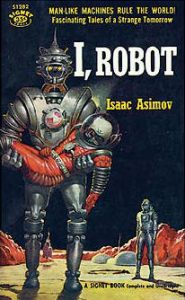I remember the first time I read Isaac Asimov’s short story “Runaround,” which features a robot’s cognitive dissonance between the “Three Laws of Robotics:”
 A robot cannot hurt a human or let a human get hurt
A robot cannot hurt a human or let a human get hurt - A robot must follow human orders (unless that contradicts the First Law)
- A robot has to protect its existence (unless that contradicts the Second Law)
Until I read that story, I never really considered the ethical dilemmas in technology. The science in the lab just seemed so distant from the ethics which govern our daily lives. However, a new class on campus showed that science and ethics are a lot closer than they seem. POLI 104P, “Science, Technology, and the Law,” offered during Spring 2017 and taught by Judge Michael Orfield, aimed to provide a moral compass in the field of science and teach what is ethical in a world that is technologically advancing beyond our imaginations.
By exploring legal issues from current and future scientific developments, Judge Orfield aims to use this class to raise awareness of scientific issues and our relationship with them in the real world. Because many of the students in his class will become future doctors and scientists, it is imperative that they understand the consequences of their research and view their work in a larger, societal context.
“One of the things I want them to get from this class is an appreciation for the effects of their science on the human population and civilization,” says Judge Orfield, explaining his goal for these future scientists in his class. “I want them to ask themselves, ‘Should we go here?’ I would hope that students … take with them an ethical evaluation of their science.”
In order to bridge the connection between science and law, Judge Orfield has designed his course to facilitate in-class discussions and debates so that students can have an immersive experience with handling difficult subjects. Through these activities, students can enhance their critical thinking ability about ethics of scientific research and view science through an interdisciplinary perspective. Judge Orfield hopes that his students will lead the way towards ethical science and add to the academic and legal conversation of scientific research outside of UC San Diego.
Currently, there is a dire need for the law to catch up to the exponential growth of science. There is a gap between the esoteric science in the lab and the legal system which governs our lives. However, classes like “Science, Technology, and the Law” can help students make informed decisions and ponder the consequences of their own research as they lead the way in scientific discoveries.
Sources:
Asimov, Isaac. I, robot. New York: New American Library, 1961. Print.
Picture:
http://dribbble.s3.amazonaws.com/users/2046/screenshots/745566/supreme_court_texture_final.jpg
https://upload.wikimedia.org/wikipedia/en/8/8e/I_Robot_-_Runaround.jpg